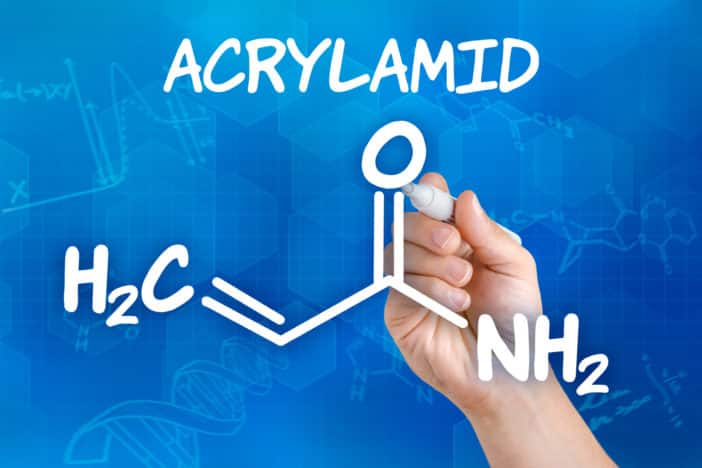Acrylamide
In its pure form, acrylamide is a white, odorless and crystalline powder that belongs to the chemical group of amides. The substance is mainly used for the production of polymers and dyes. However, since 2000, acrylamide has been repeatedly detected in various starch-containing foods.
The reason: acrylamide is formed during baking, frying, roasting, grilling and deep-frying in the so-called Maillard reaction. If foods containing starch and cereals are heated to over 180 degrees Celsius when dry, a particularly large amount of acrylamide is formed. Anyone who consumes foods such as French fries or potato chips several times a week must expect elevated acrylamide levels in the blood.
Effects on the human body
To date, it has still not been possible to definitively clarify the exact effects of acrylamide on our health. However, animal studies have shown that the substance is highly likely to be mutagenic and carcinogenic. As announced by the World Health Organization (WHO), among others, the consumption of foods with acrylamide contamination is likely to contribute to the general risk of cancer. A maximum limit of 0.0001 milligrams per liter of drinking water has been established within the Drinking Water Ordinance.
Considering human studies, no clear conclusions can be drawn regarding the association between acrylamide exposure and carcinogenesis. The German Federal Institute for Risk Evaluation (BfR) assessed the human studies, which came to inconsistent results. Thus, acrylamide may represent a potentially toxic and hazardous chemical compound for human health, although the assessment of the risk, due to the different results, is difficult.
Acrylamide in cosmetics
Traces of acrylamide have also been detected in cosmetics. By using such cosmetics, the body absorbs this contamination through the skin. Scientists have already stated that its use would pose an “unacceptably high risk of cancer”. This is mainly due to the polyacrylamides used in the products as binders and film formers. Polyacrylamides often contain traces of the harmful acrylamide as an impurity. Some time ago, therefore, the legislator set maximum quantities and limits for the residual content of acrylic amide in polyacrylamide. For cosmetic articles that are rinsed off after use, the limit is 0.5 milligrams per kilogram of product. For articles that remain on the skin, the maximum value is even 0.1 milligrams per kilogram of product.
Hair shampoos and body lotions are usually particularly affected, because polyacrylamides are frequently used in these products. This is because the substance has an antistatic effect, it supports foam formation and also serves as a binding and adhesive agent at the same time.
A residual also exists when the film-forming and antistatic raw material polyquarternium-7 is used. The use of this polymeric quaternary ammonium salt of dimethyldiallylammonium chloride thus represents a further source of acrylamide in cosmetic products that is not yet subject to a limit value. The BfR is calling for a limit value to be set for the residual content of acrylamides in other cosmetic raw materials.
Here, therefore, consumers must take action themselves by resorting to high-quality cosmetics without corresponding ingredients.
It is better to avoid products with acrylamide contamination
Whether frequent consumption of potato chips or the use of contaminated cosmetics, the health-conscious consumer should rather avoid them in order to avoid possible risks. Due to the potential damage to health and negative effects on human reproduction, the risk is constantly being researched and monitored by the authorities. Buying natural cosmetics or traditional cosmetics without synthetic polymers will definitely help to avoid possible risks.
We at Cosmacon develop high quality cosmetics for you according to your wishes, just contact us!
Sources:
Simple, selective and fast detection of Acrylamide based on glutathione S-transferase.; Bucur MP, Bucur B, Radu GL.RSC Adv. 2018 Jul 2;8(42):23931-23936.
Risk of exposure to Acrylamide.; Bušová M, Bencko V, Veszelits Laktičová K, Holcátová I, Vargová M.Cent Eur J Public Health. 2020 Oct;28 Suppl:S43-S46.
Health Implications of Acrylamide in Food. World Health Organization.; Report of a Joint FAO/WHO Consultation WHO Headquarters. 2002.
Bundesinstitut für Risikobewertung (BfR). Zwei Jahre Acrylamid – Eine Bilanz aus Sicht der Risikobewertung. 2004.
Chemistry, biochemistry, and safety of acrylamide. A review.; Mendel Friedman J Agric Food Chem. 2003 Jul 30;51(16):4504-26.
Scientific Opinion on acrylamide in food.; EFSA Panel on Contaminants in the Food Chain (CONTAM). EFSA Journal 2015;13(6):4104.
Amended final report on the safety assessment of polyarcylamide and Acrylamide residues in cosmetics. Int J Toxicol. 2005;24 Suppl 2:21-50.
